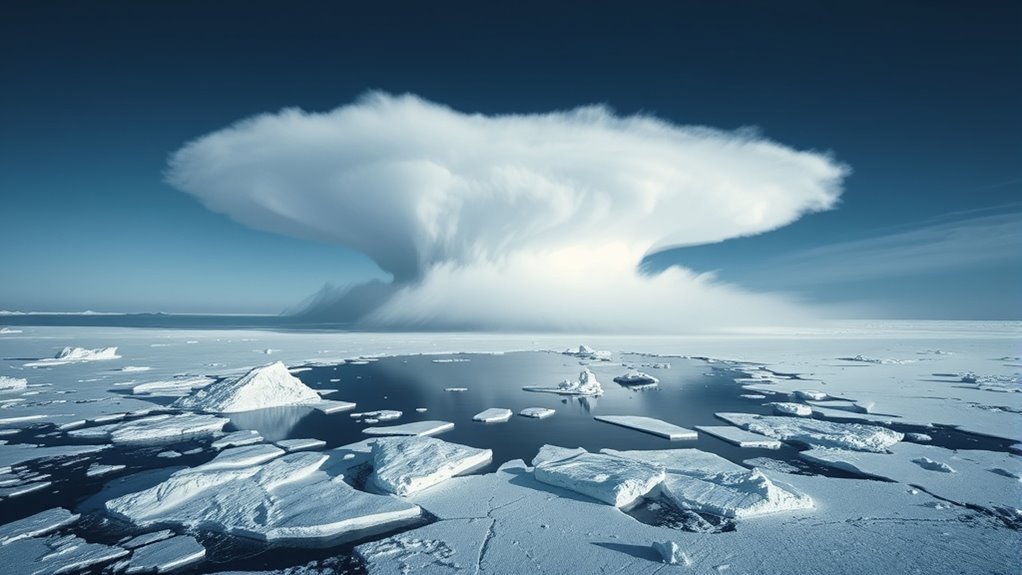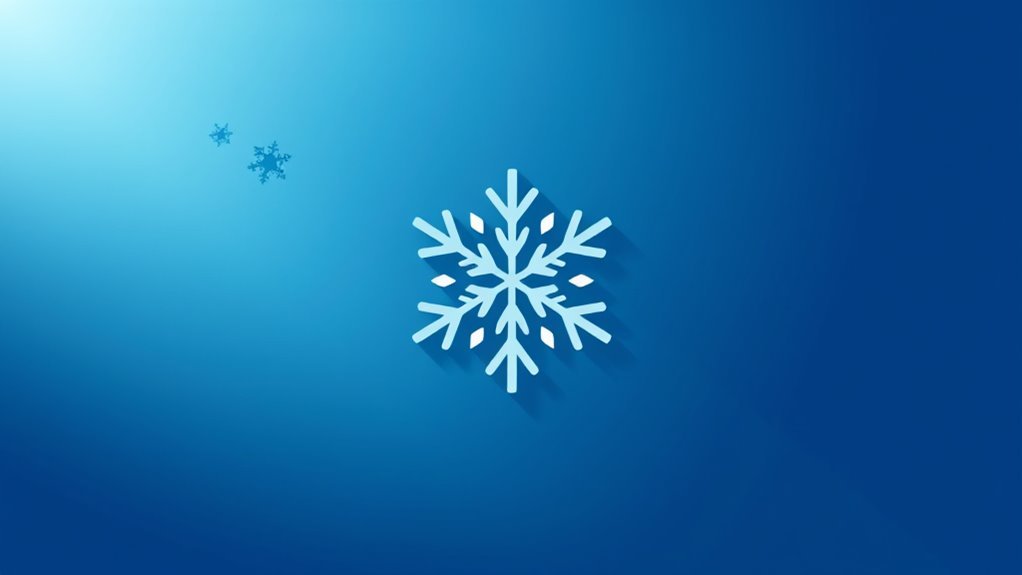Arctic air masses greatly influence the formation of heavy snow squalls due to their cold temperatures and high density. When these frigid air masses collide with warmer, moist air, dramatic temperature gradients emerge, leading to rapid cooling, condensation, and intense snow squalls. This interaction can generate hazardous conditions such as low visibility and slippery roads. Understanding the underlying mechanisms and impacts of these phenomena reveals essential understandings into winter weather patterns and community preparedness strategies.
Main Points
- Arctic air masses are cold and dense, creating sharp temperature gradients when they collide with warmer air, leading to snow squalls.
- The interaction of Arctic air with moist, warm air enhances lifting, resulting in rapid cooling, condensation, and cloud formation.
- Temperature inversions can trap cold air near the surface, prolonging snow squall conditions and increasing precipitation potential.
- Snow squalls caused by Arctic air can lead to sudden heavy snowfall and hazardous travel conditions, significantly impacting public safety.
- Effective forecasting of snow squalls relies on real-time data and understanding of Arctic air mass behavior, aiding community preparedness and response.
Understanding Arctic Air Masses
Arctic air masses, defined by their cold temperatures and high pressure, play an essential role in influencing weather patterns across extensive regions.
Originating from the polar regions, these air masses are distinguished by their density and stability, which contribute to their ability to remain in place for prolonged periods. As they move southward, they interact with warmer air masses, creating sharp temperature gradients.
This interaction often leads to notable weather phenomena, such as snow squalls and blizzards. The cold air inhibits rising warm air, causing moisture to condense rapidly and precipitate. Consequently, areas affected by Arctic air masses frequently experience drastic drops in temperature, accompanied by cold winds and snowfall.
The presence of these air masses can modify local climates, leading to harsher winters in their path. Understanding Arctic air masses is vital for predicting winter weather and preparing for potential impacts on communities and ecosystems.
The Mechanism of Snow Squall Formation

When cold Arctic air masses collide with warmer, moist air, a process is initiated that can lead to the rapid development of snow squalls. This interaction often occurs along frontal boundaries, where the denser, cold air pushes underneath the lighter, warm air, forcing it to rise quickly.
As the warm air ascends, it cools and condenses, forming clouds and precipitation. The instability created by this rapid lifting can improve the vertical development of clouds, leading to intense localized snowfall.
Furthermore, the temperature gradient between the Arctic air and the moist air contributes to the strength of the resulting snow squall. As the cold air continues to surge, it can create strong winds that exacerbate the snowfall intensity, reducing visibility and creating hazardous conditions.
This mechanism, thus, highlights the critical role of air mass interactions in the formation of snow squalls.
The Role of Temperature and Moisture
Temperature and moisture are critical factors influencing the formation and intensity of snow squalls.
Temperature inversions can trap cold air near the surface, while the availability of moisture determines the potential for precipitation.
Understanding these dynamics is essential for predicting the behavior of Arctic air masses and their associated snow events.
Temperature Inversion Effects
Although often overlooked, temperature inversion plays an important role in shaping weather patterns, particularly in Arctic regions.
During temperature inversions, warmer air traps colder air near the surface, creating a stable atmospheric layer. This phenomenon can lead to the accumulation of snow and the development of snow squalls as the trapped cold air becomes saturated with moisture.
The stability provided by the inversion can improve localized lift, causing heavy precipitation when the conditions align. In addition, inversions can inhibit vertical mixing, allowing cold air to persist longer, which may contribute to persistent snow events.
Understanding these dynamics is vital for predicting the formation and intensity of snow squalls in Arctic environments, where temperature inversions frequently occur.
Moisture Availability Impact
The availability of moisture greatly influences the formation of snow squalls, particularly in Arctic regions where temperature inversions can trap cold air. In these settings, the interaction between moisture and cold air is essential for squall development.
When moist air is forced to rise over the cold surface, it cools rapidly, leading to condensation and snow formation. This dynamic can produce intense localized snowfall, contributing to hazardous conditions.
Factors such as wind patterns, ocean currents, and local topography also play important roles in moisture availability.
- Moisture sources can include nearby oceans and lakes.
- Wind direction affects moisture transport.
- Temperature inversions can improve moisture retention.
- Snow squalls can occur with minimal moisture if conditions are ideal.
- Arctic environments can experience rapid changes in moisture levels.
Impacts of Snow Squalls on Travel and Safety
Snow squalls can markedly disrupt travel, leading to delays and hazardous conditions on roadways.
These sudden bursts of heavy snowfall create low visibility and slippery surfaces, posing serious safety risks for drivers.
Understanding these impacts is essential for implementing effective precautions and ensuring safer travel during such weather events.
Travel Disruptions and Delays
Travel disruptions often become inevitable when snow squalls sweep across regions, creating hazardous conditions for motorists and travelers alike.
These sudden bursts of heavy snowfall can lead to reduced visibility, slippery roads, and traffic delays, greatly affecting travel plans. As a result, many travelers may experience unexpected detours, cancellations, or extended travel times.
- Sudden road closures due to accumulation
- Increased likelihood of accidents and collisions
- Public transportation delays and cancellations
- Strain on emergency services responding to incidents
- Travelers stranded in vehicles or at terminals
The impact of snow squalls can have a cascading effect on total travel safety, leading to heightened anxiety and increased caution among those maneuvering through affected areas.
Safety Hazards and Precautions
Hazards associated with snow squalls greatly increase the risks faced by motorists and pedestrians alike.
These sudden bursts of heavy snowfall can drastically reduce visibility, leading to dangerous driving conditions. Motorists may experience loss of control, resulting in accidents or skidding off the road. Additionally, snow accumulation can create slippery sidewalks and roadways, posing a threat to pedestrians.
To mitigate these risks, it is advised that individuals stay informed about weather conditions and avoid travel during snow squalls if possible.
If travel is necessary, maintaining a safe distance from other vehicles and using winter tires can improve safety. Moreover, carrying emergency supplies in vehicles, such as blankets and food, is essential for preparedness in case of unexpected delays or breakdowns.
Predicting Snow Squalls: Meteorological Techniques
Meteorologists employ a variety of techniques to predict snow squalls, utilizing advanced technology and atmospheric data analysis. These techniques are essential for providing timely warnings and ensuring public safety.
One primary method involves the use of numerical weather prediction models, which simulate atmospheric conditions to forecast potential snow squall events. Additionally, satellite imagery plays a significant role in monitoring cloud formations and moisture levels associated with Arctic air masses.
Ground-based radar systems further improve prediction capabilities by tracking precipitation intensity and movement. Forecasters also analyze historical data to identify patterns linked to snow squall occurrences.
- Numerical weather prediction models
- Satellite imagery for cloud monitoring
- Ground-based radar systems
- Historical data analysis
- Real-time atmospheric data collection
Together, these tools and methods promote a thorough understanding of snow squall formation, allowing meteorologists to issue alerts and prepare communities for sudden weather changes.
Case Studies of Notable Snow Squalls
While snow squalls can occur with little warning, several notable case studies illustrate their sudden and impactful nature.
One remarkable event occurred in February 2015 across the northeastern United States, where a rapidly moving Arctic air mass collided with warmer air, resulting in intense snow squalls. Visibility dropped to near zero, causing hazardous driving conditions and multiple accidents.
Another case, in March 2021, affected parts of the Midwest. A powerful cold front swept through, leading to heavy snow squalls that produced snow accumulations of up to six inches in under an hour. The squalls disrupted transportation and prompted emergency responses.
In both instances, the combination of Arctic air and localized atmospheric conditions created the perfect environment for severe snow squall formation.
These case studies underscore the unpredictable and extreme nature of winter weather events in regions influenced by Arctic air masses.
Preparing Communities for Winter Weather Challenges
As winter approaches, communities must proactively prepare for the challenges posed by severe weather, particularly snow squalls. Effective preparation can mitigate the impact of these sudden, intense weather events.
Local governments and organizations play a critical role in establishing strategies that improve public safety and awareness.
Key measures include:
- Community Education: Informing residents about snow squalls, their characteristics, and safety precautions.
- Emergency Kits: Encouraging families to assemble emergency kits containing food, water, and medical supplies.
- Road Maintenance: Ensuring that snow removal equipment and resources are ready for rapid deployment.
- Communication Systems: Establishing reliable channels for weather alerts and updates to keep the public informed.
- Training Programs: Providing training for emergency responders to effectively manage snow squall-related incidents.
Common Questions
How Do Arctic Air Masses Differ From Other Air Masses?
Arctic air masses are defined by their cold temperatures and low moisture content, differing from tropical air masses, which are warm and humid. This stark contrast influences weather patterns and conditions across various regions.
Can Snow Squalls Occur in Warmer Climates?
Snow squalls can occur in warmer climates, although less frequently. These intense snow events require specific atmospheric conditions, such as moisture and temperature contrasts, which can be present even in regions typically defined by milder temperatures.
What Are the Signs of an Impending Snow Squall?
Signs of an impending snow squall include rapidly decreasing temperatures, sudden gusts of wind, darkening skies, and reduced visibility. These indicators often precede intense snowfall, creating hazardous conditions that can develop unexpectedly and swiftly.
How Long Do Snow Squalls Typically Last?
Snow squalls typically last between 30 minutes to a couple of hours. Their intensity can vary greatly, leading to sudden and severe conditions, resulting in reduced visibility and hazardous travel circumstances for those caught in them.
Are There Specific Geographic Areas More Prone to Snow Squalls?
Certain geographic areas, particularly the Great Lakes region, northeastern United States, and parts of Canada, are significantly prone to snow squalls due to specific climatic conditions that encourage their formation and intensity during winter months.

